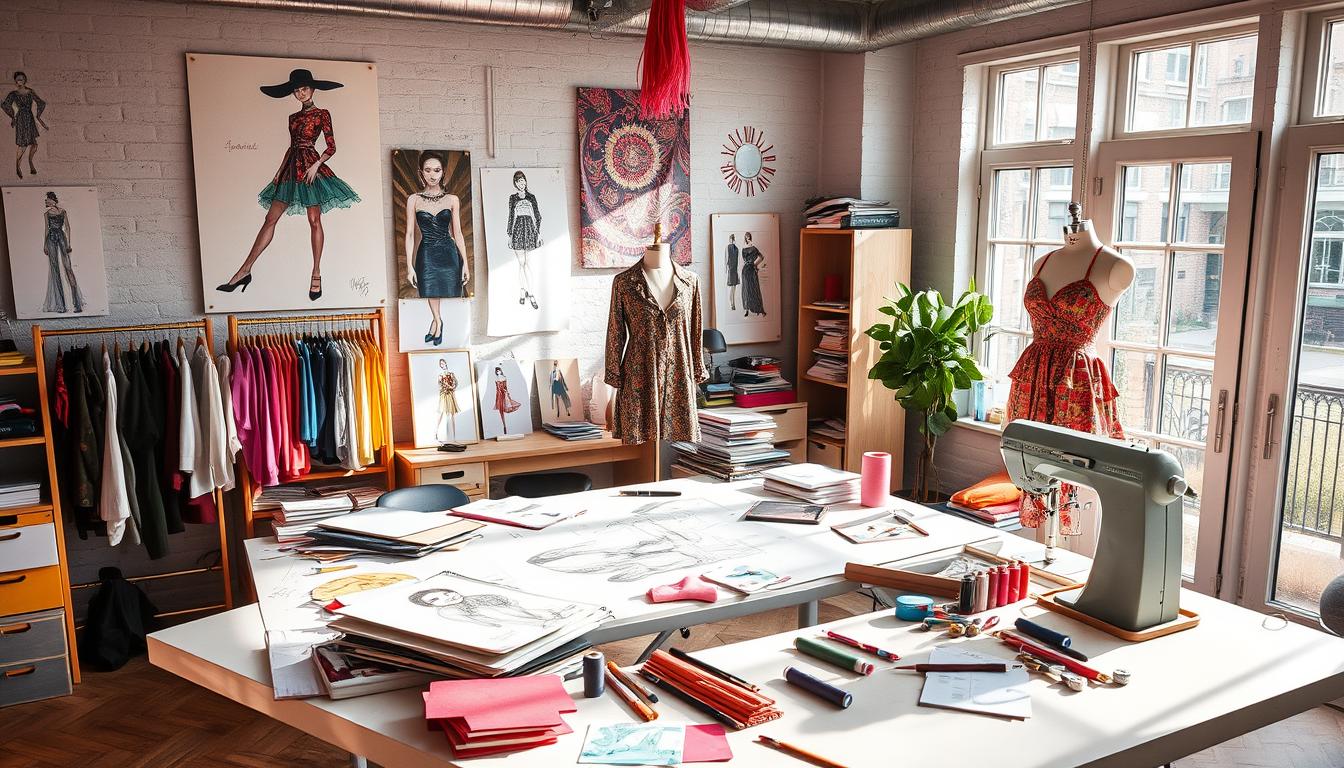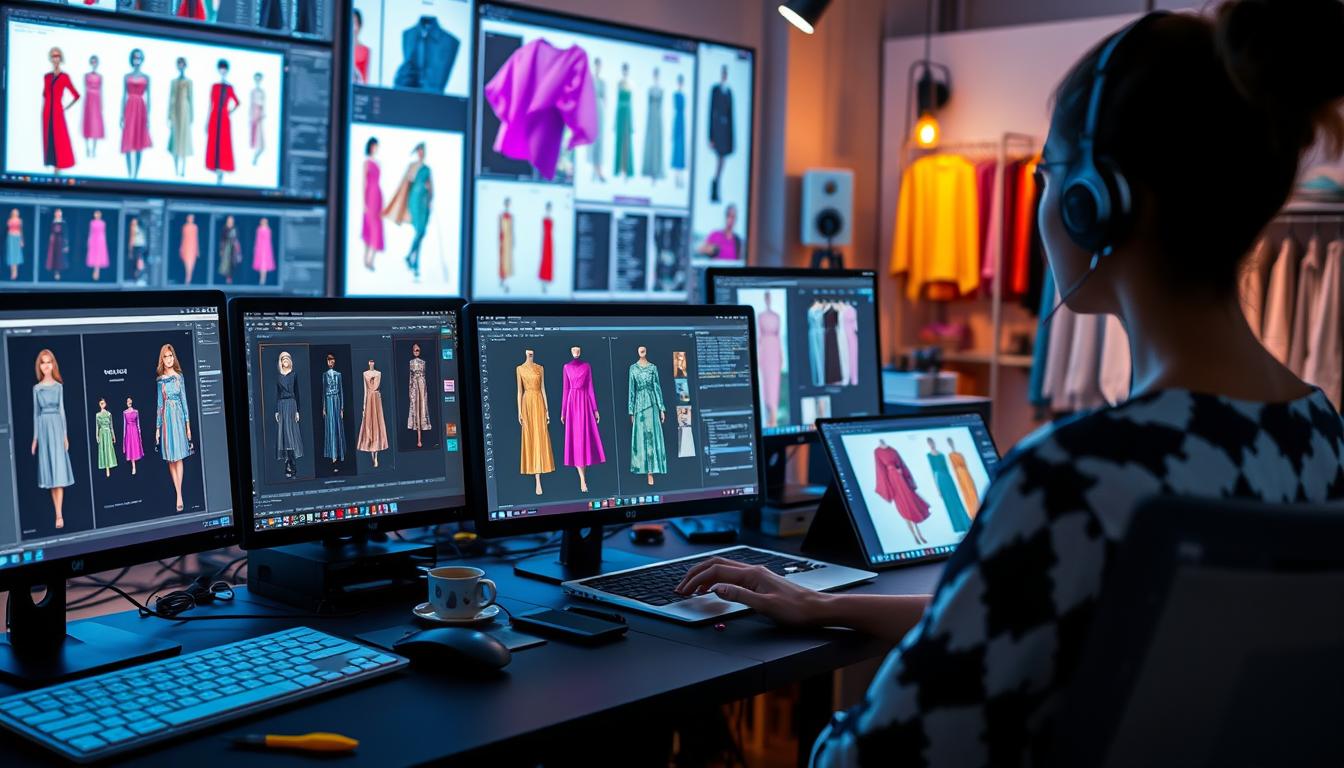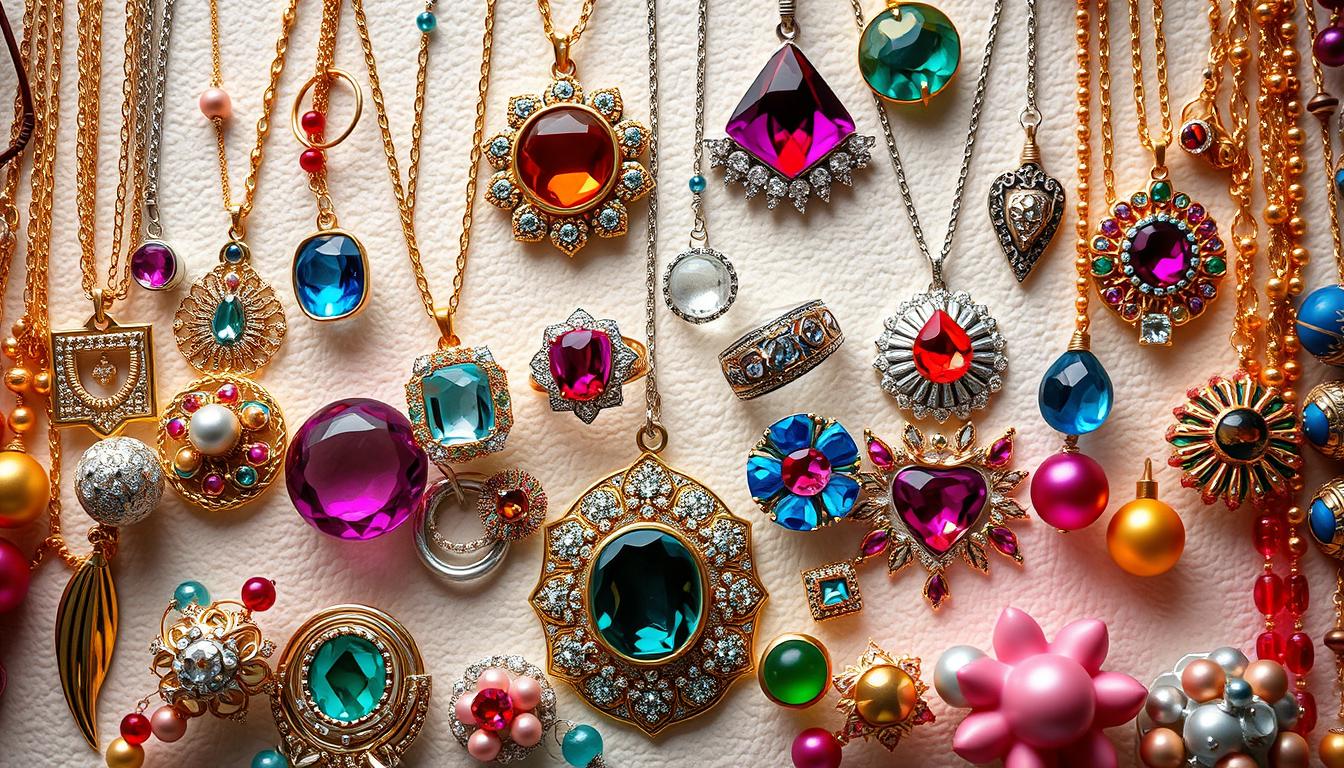A Fashion Designer is a creative person who makes clothes, accessories, and shoes. They use their artistic skills to create unique and stylish designs. Fashion Designers look at trends, make design ideas, draw sketches, pick out fabrics, and watch over the making process.
They work with teams to make their designs real. They make sure their designs fit with the company’s goals and what’s popular in the market.
Key Takeaways
- Fashion Designers are creative professionals who design and create clothing, accessories, and footwear.
- Key responsibilities include researching trends, creating design concepts, sketching designs, selecting fabrics, and overseeing production.
- Fashion Designers collaborate with teams to bring their designs to life and align with business strategy and market trends.
- Proficiency in design software and the ability to travel for research and product development are common requirements.
- A bachelor’s degree in design or fine arts is the preferred educational background for Fashion Designers.
Overview of Fashion Design Careers
Fashion design is key in the clothing world, shaping trends and what people buy. Fashion design job duties include coming up with new designs and managing production. There are many fashion design career opportunities for those starting out.
Importance of Fashion Design
Fashion designers lead the change in clothes and accessories. They turn their ideas into real products that excite and inspire people. Their work affects everything from fancy dresses to everyday clothes.
Career Opportunities in Fashion Design
- Working for big fashion brands, making collections for everyone
- Designing for luxury brands, creating unique and desirable fashion
- Focus on special areas like sportswear, kids’ clothes, shoes, or accessories
- Starting your own fashion line or brand, working for yourself
Future Trends in Fashion Design
The fashion world is always changing, with new trends and needs. There’s more focus on being green, digital fashion, and clothes that fit you perfectly. Designers who can keep up and be creative will do well in the future.
The fashion design field has lots of fashion design career opportunities for creative, skilled, and business-savvy people. As the industry keeps growing, the need for fresh and flexible fashion designers will keep rising.
Key Responsibilities of a Fashion Designer
Fashion designers are key in shaping what we wear every day. They handle many tasks, from coming up with new designs to making sure they’re made right. Let’s look at what a fashion designer does.
Concept Development
Designers create designs that people want to wear. They pick colors, patterns, and prints for each season. They also come up with new ideas that show off the brand or collection.
Fabric and Material Selection
Designers know a lot about fabrics and materials. What they choose affects how clothes look, last, and feel. They work with suppliers to find the best fabrics and trims for their designs.
Sketching and Design
Sketching and designing are the basics for designers. They make detailed sketches and drawings to share their ideas. They work on making designs better, create mood boards, and check if the final product fits the brand’s standards.
| Fashion Designer Responsibilities | Fashion Design Job Duties |
|---|---|
| Concept Development |
|
| Fabric and Material Selection |
|
| Sketching and Design |
|
In short, fashion designers do it all, from starting ideas to making sure they’re made right. They make sure their designs meet the fashion world’s changing needs and what people want to wear.
Required Skills for Fashion Designers
Fashion designers need a mix of creativity and technical skills to succeed. They work from idea to final product, needing many skills that change over time.
Creativity and Innovation
Creativity and innovation are key in fashion design. Designers must see color, fabric, and shape well. They also need to imagine and make their ideas real. The IFA Paris’ Bachelor Fashion Design program helps students find their creative voice and try out design ideas.
Technical Skills
Designers also need technical skills. They must know how to make clothes, create patterns, and use design software like CLO3D or Lectra. IFA Paris teaches students about new tech like virtual reality and 3D printing to improve designs.
Communication and Collaboration
Good communication and teamwork skills are crucial. Designers work with many people to make their designs happen. IFA Paris focuses on teaching these skills for better teamwork in the fashion world.
In short, designers need creativity, technical skills, and business knowledge. Programs like IFA Paris help students get the fashion design skills and fashion designer qualifications needed to succeed in fashion.
Educational Requirements for Fashion Designers
Fashion designers usually need a bachelor’s degree in fashion design, fine arts, or a related field. These programs teach design principles, textile technology, and how to make garments. Many designers also take extra courses or get certifications in fashion merchandising, management, or pattern making.
Degrees and Certifications
Most fashion designers have a bachelor’s degree, which takes about four years. Some might get a master’s degree for more advanced training and leadership roles. There are also associate’s degrees, which take about two years to finish.
Relevant Courses and Specializations
- Fashion design
- Textile design
- Garment technology
- Fashion merchandising
- Fashion management
- Pattern making
- Accessory design
- Footwear design
Staying current with trends is key for fashion designers. They need to keep learning to meet fashion design job requirements and fashion designer qualifications. Many designers get certifications or take postgraduate programs to specialize in certain fashion areas.
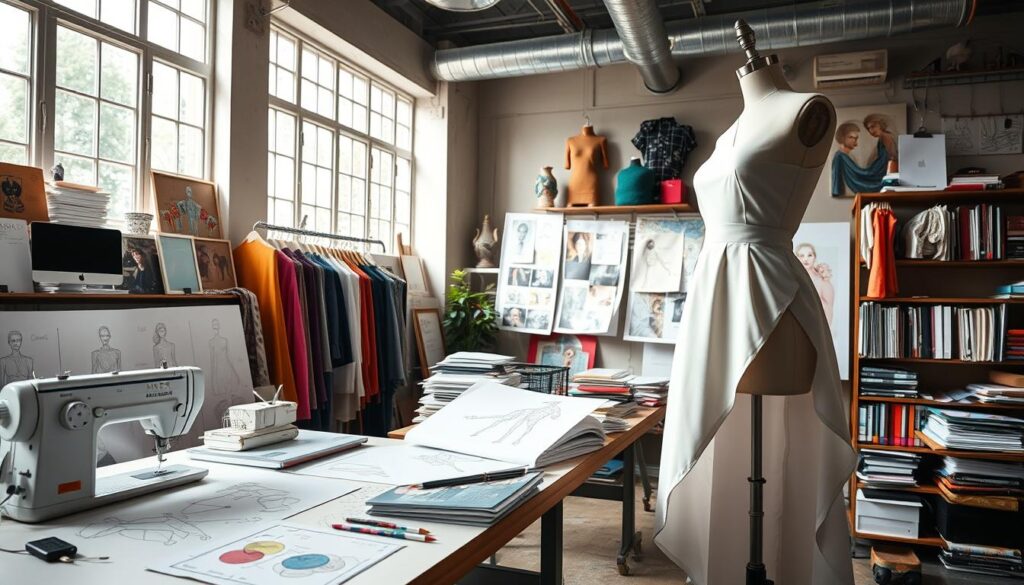
“Fashion is not something that exists in dresses only. Fashion is in the sky, in the street, fashion has to do with ideas, the way we live, what is happening.” – Coco Chanel
Experience Needed for Fashion Designers
Aspiring fashion designers need to put in time and effort to succeed. Internships and work placements during school are key. They help build skills and expand professional networks.
Internships in Fashion
Many fashion design programs require internships. This lets students apply what they learn in real-world settings. Interning at fashion houses or design studios gives hands-on experience.
It’s a chance to learn from experts and make industry connections. You’ll work on concept development, fabric and material selection, and sketching and design.
Entry-Level Positions and Growth
- Fashion design graduates often start as design assistants or junior designers.
- With experience, they move up to junior designer and then senior designer or creative director roles.
- Online retailing has made freelancing and self-employment more common in fashion design.
| Job Zone | Education | Related Experience | Job Training | SVP Range | Skills Needed |
|---|---|---|---|---|---|
| Medium preparation needed | Requires training in vocational schools, related on-the-job experience, or an associate’s degree | Previous work-related skill, knowledge, or experience is required | Typically involves one to two years of training with on-the-job experience and informal training | 6.0 to less than 7.0 | Active Listening, Critical Thinking |
Creating a strong portfolio and keeping a professional network is crucial. With hard work, creativity, and experience, designers can move up. They shape the future of fashion.
Tools and Technologies in Fashion Design
Fashion designers use many tools and technologies to make their ideas come to life. They use digital design software and traditional sewing tools. These tools are key to their job and fashion design skills.
Design Software Platforms
Software like Adobe Illustrator, Photoshop, and CAD is vital for fashion designers. It helps them create digital designs, technical specs, and virtual prototypes. These tools make it easier to try out designs, colors, and materials.
Sewing and Production Tools
Even with digital tools, sewing skills are still important. Designers use measuring tapes, scissors, and needles to make real samples. They also need to know about production tools like curve rulers and muslin fabric.
| Tool | Purpose |
|---|---|
| Measuring Tape | Standard tool for taking measurements and ensuring accurate fit |
| Scissors | Various types used for cutting different fabric materials |
| Tailor’s Chalk | Widely used for marking dimensions on fabric and making alterations |
| Adjustable Dressmaker | Crucial for checking garment fitting without requiring real-life models |
| Needles and Threads | Essentials for last-minute alterations during fittings |
| Curved Rulers | Tools used for pattern drafting and adjustments in garments |
| Muslin Fabric | Affordable fabric widely used by fashion designers for experimenting |
In summary, the fashion designer job role combines digital skills with traditional techniques. A wide range of tools and technologies support the creative process from start to finish.
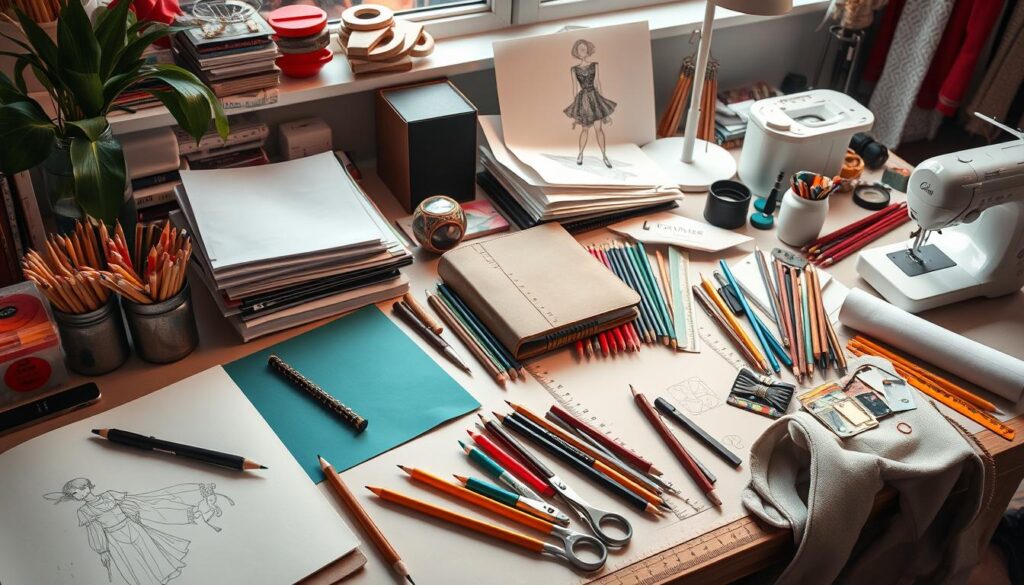
Understanding Fashion Trends
As a fashion designer, keeping up with trends is key. You need to do lots of market research and watch global trends closely. Designers travel to fashion events, read industry news, and use special forecasting tools to make sure their designs are on point.
Research and Market Analysis
Good fashion designers know how to do market research. They study what people like, read industry reports, and watch global styles. By looking at sales data and what people buy, they decide on the best styles, colors, and materials.
Trend Forecasting Techniques
- Attending fashion shows and trade events to observe the latest runway trends
- Subscribing to industry publications and online trend-tracking services
- Conducting surveys and focus groups to gather insights from fashion-conscious consumers
- Analyzing social media and online data to identify popular styles and influencer-driven trends
- Collaborating with trend forecasting agencies to gain access to comprehensive trend reports
Mastering trend research and forecasting helps designers stay ahead. They create designs that match the current fashion mood. This keeps them competitive in the fast-changing fashion world.
| Trend Forecasting Techniques | Advantages | Disadvantages |
|---|---|---|
| Attending Fashion Shows | Firsthand observation of emerging trends | Expensive and time-consuming |
| Industry Publications | Comprehensive and up-to-date trend insights | Subscription fees can be costly |
| Consumer Surveys | Direct feedback from the target market | Time-consuming data collection and analysis |
| Social Media Analysis | Real-time tracking of popular styles and influencer trends | Data can be fragmented and difficult to interpret |
| Trend Forecasting Agencies | Comprehensive and reliable trend reports | Subscription fees can be high |
Using different trend forecasting methods helps designers stay ahead. They create designs that appeal to their audience and boost sales in the competitive fashion world.
Balancing Creativity and Business
Successful fashion design careers need more than just creativity. Fashion designers must also understand the business side well. This balance between art and business is key for lasting success in the fashion designer job role.
Marketing and Self-Promotion
Good marketing and self-promotion are vital for fashion designers, especially freelancers. They must show their work to buyers and work with sales and production teams. Building a strong personal brand is also crucial.
This means having a clear visual identity, using social media, and networking. It’s about presenting yourself well in the industry.
Budget Management and Costing
Managing budgets and costs is also essential. Fashion designers need to know the production costs and pricing strategies for profit. They must understand market trends, materials, and manufacturing.
Designers who balance creativity and business skills are usually the most successful. They know how to make their designs both beautiful and profitable.
“Balancing creativity with commercial viability is the key to sustainable success in fashion design. The most iconic brands have mastered this delicate equilibrium.” – Jane Doe, Fashion Design Consultant
Brands like Chanel and Nike show the importance of this balance. Chanel keeps its heritage while staying current and controlling costs. Nike focuses on creative design, technology, and global expansion through data.
Aspiring fashion designers can learn from these brands. They should develop skills that mix creativity with business. This might mean getting more education, building a diverse team, and improving communication between creative and business sides.
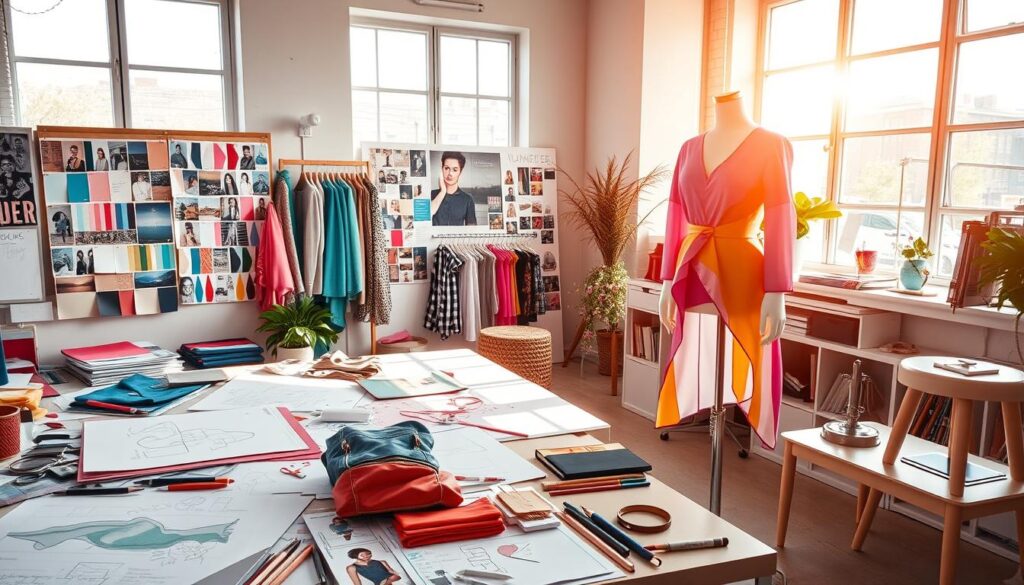
By mastering the art of balancing creativity and business, fashion designers can achieve long-term success in the fashion world.
Working Environment for Fashion Designers
The work environment for fashion designers can change a lot. It ranges from modern offices to cozy design studios. This depends on the size and type of the fashion company they work for.
Studio vs. Office Settings
Big fashion companies usually have a team setup. Designers, pattern makers, seamstresses, and project managers work together in a big office. On the other hand, small brands or solo fashion designers might work from home or a small studio.
Freelancing vs. Working for Fashion Houses
Fashion designers often work long hours, especially when deadlines are tight. Freelancers have to travel a lot for meetings, shows, and buying supplies. Those working for big fashion houses have more set roles and work with a team.
No matter where they work, fashion designers must keep up with trends and know what customers want. They also need to be organized and detail-oriented.
“Fashion design is not just about creating beautiful garments; it’s about understanding the ever-changing needs and desires of the consumer.” – Sara Johnson, Head of Design at Vogue Magazine
Networking in the Fashion Industry
Networking is key to success in the fashion design career. 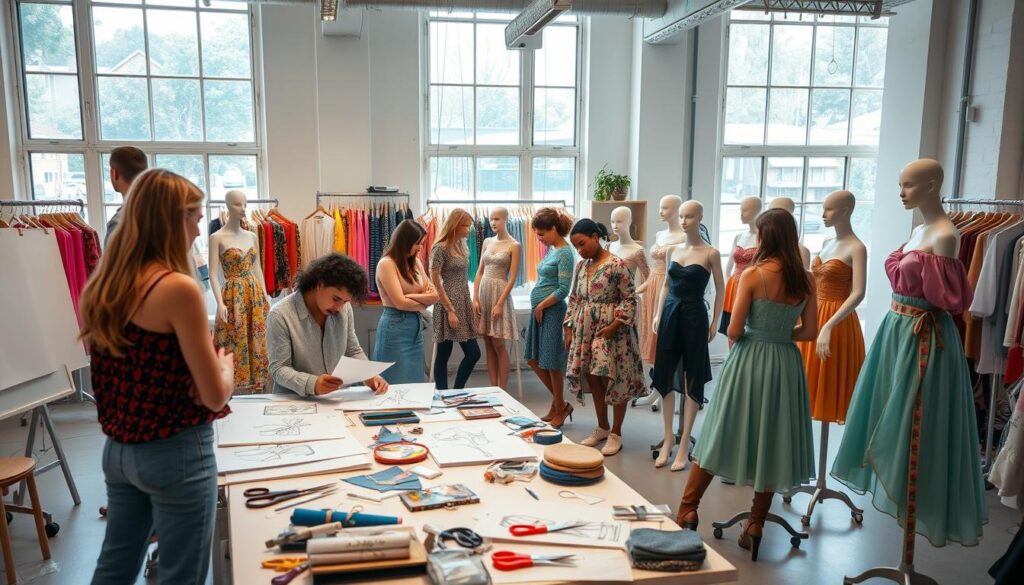 Designers need to connect with peers, suppliers, and retailers. Events and trade shows are great for showing off work and finding new fashion designer job role chances.
Designers need to connect with peers, suppliers, and retailers. Events and trade shows are great for showing off work and finding new fashion designer job role chances.
Building Professional Relationships
Good networking helps designers grow and find new trends. It lets them learn from others and find new ways to work together. Strong ties can lead to jobs, projects, and new markets.
Attending Fashion Events and Trade Shows
Going to industry events is a smart move for designers. It’s a chance to show designs, learn from experts, and see new trends. These events can spark new ideas and help designers grow.
“Networking in the fashion industry is crucial for staying relevant and unlocking new opportunities. It’s not just about who you know, but how you can collaborate and support each other’s creative visions.”
By getting involved in networking, designers can build a strong brand. This helps them stand out in the competitive fashion world.
Challenges in the Fashion Design Field
The fashion design field is very competitive, especially in womenswear. Fashion designers face many challenges. These include tight deadlines and the need to create new designs fast.
They must balance creativity with making designs that sell well. This requires being resilient, adaptable, and able to work well under pressure.
High Competition
The fashion industry is very competitive. Many designers want to catch the eye of consumers and industry leaders. With so many aspiring fashion designers, it’s hard to stand out.
Designers need to keep improving their skills and know the latest trends. They also need a strong portfolio to attract clients and employers.
Tight Deadlines
Fashion designers work under tight deadlines. They must create collections quickly to meet seasonal demands. This fast pace requires designers to work efficiently and manage their time well.
Meeting these deadlines can be stressful. It tests designers’ ability to handle pressure.
“The fashion industry is not for the faint of heart. It demands a unique blend of creativity, technical expertise, and the ability to adapt to an ever-evolving landscape of trends and consumer preferences.”
To succeed, fashion designers need a strong work ethic and great problem-solving skills. They must also understand the industry well. By facing these challenges and improving their skills, designers can thrive in the fashion world.
Job Outlook and Salary Information
Salaries for fashion design careers change a lot. This depends on experience, where you work, and the job itself. Starting jobs like design assistants might earn $16,000 to $18,000 a year. Junior designers can make about $25,000 yearly.
More seasoned designers and creative directors can earn between $42,000 and over $85,000. This shows how salaries can vary a lot.
The job growth outlook for fashion designers is a bit slow. It’s expected to grow by 3% in the next ten years. This is slower than most jobs. Jobs in fashion are affected by the economy and how much people spend.
Most fashion designers work in the apparel industry (35%), management (18%), or on their own (12%). They make the most money in the motion picture and video industries ($79,130), management ($76,300), and apparel manufacturing ($68,260).

